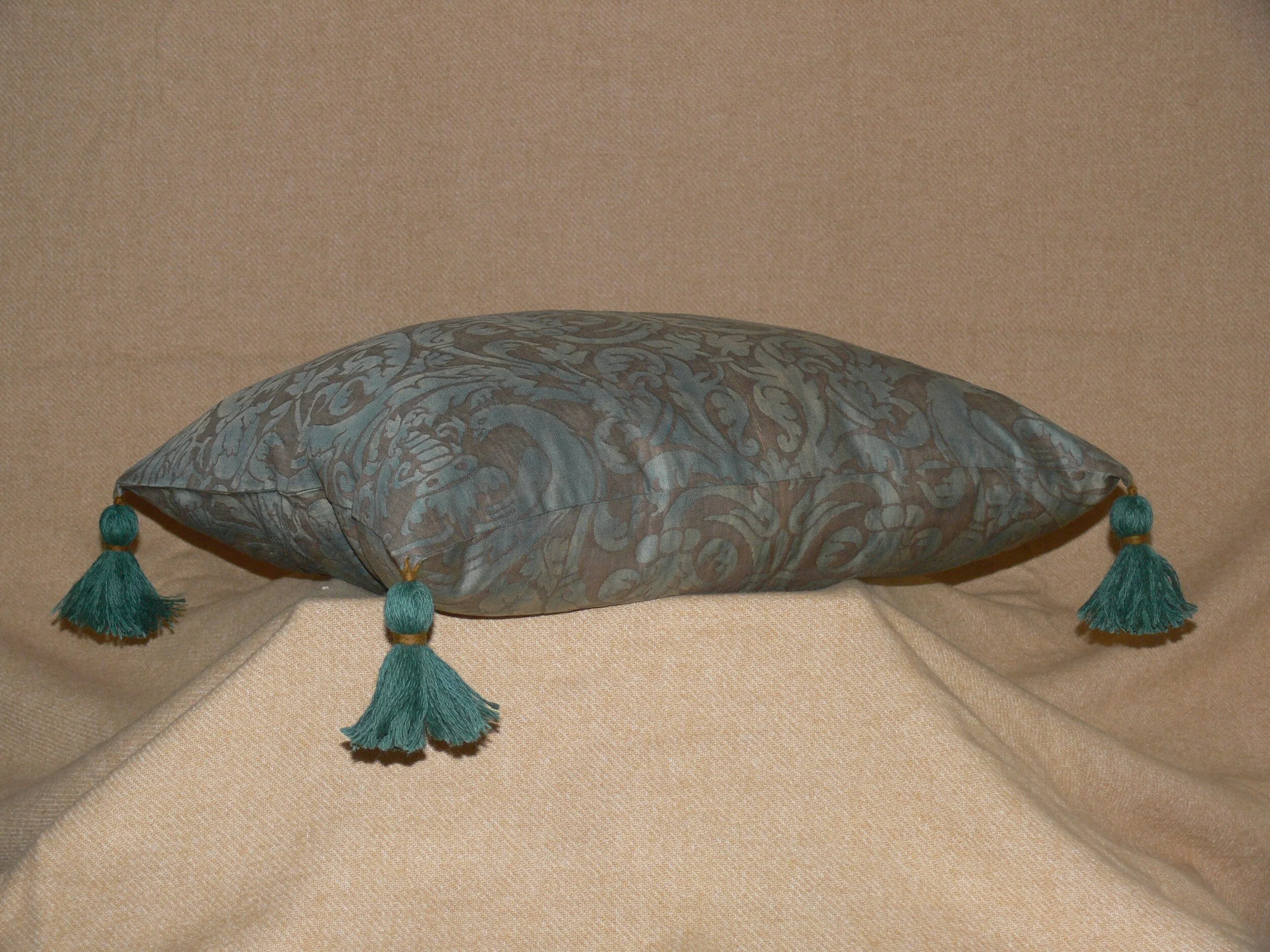Household Furnishings: Cushions
During almost every time period it is easy to find at least one type of chair that depends on a removable cushion rather than upholstery to render it a comfortable place to sit. Over the past four centuries, a combination of fashion and the relative cost of textiles has dictated whether these seating accessories were plump or relatively flat; austerely plain or elaborately ornamented by cord, fringe, and/or tassels.
Period prints and paintings provide valuable sources of illustration for the customs and use of cushions during specific time periods. By studying them, it is possible to better understand both the decorative and functional roles played by cushions in period interiors. Depending on where and how a cushion was used, the fabrics employed vary from opulent to utilitarian. Some were clearly for show. Richly colored embroidery, whether professionally made or created by members of the household, demonstrated the affluence and taste of its owner.
It is clear in some period images that cushions did not necessarily “belong” to a specific chair, but were used as needed in an interior setting. I am particularly interested in exploring how these “freelancing” cushions may have been used. Did they remain in the same room, or were they moved throughout a house as needed? Are they descended from cushions that may have been transported by their owners during travel, providing comfort en route as well as in the household of their destination?
Because I learn both from studying artifacts as well as from the experience of fashioning replicas of them with my own hands, each project provides new insight. The process of gathering suitable materials requires a discerning eye; as well as an understanding of how materials can or cannot be altered. Natural fibers (wool/mohair, silk, linen and cotton) form an obvious palette from which to choose. They are, however, merely materials derived from living organisms. Over centuries the qualities of these fibers have altered -- sometimes as a result of selective breeding and in other instances by necessary adaptation to the environment in which they have grown. I’m not so much concerned with whether the changes have improved the product (and many have), but just how they affect its texture, dye affinity and overall appearance. In any of these factors hide consequences for how well it will replicate the original qualities of its ancestors. Whether I am choosing fabric for the outer cushion cover, or the filling medium to go inside it, I am guided by the scholarly work of others, my own study of artifacts, as well as the experience of my own handwork.
Within the study of period furnishings, an interesting layer of complexity emerged during the early 20th century. Among American collectors of that time, there was avid interest in early decorative arts of nearly every kind. The happy result of this passion for Americana was that many artifacts were preserved, major museum collections were founded to protect them, and broad foundations were laid for the field of study being carried on today. It was a distinct advantage that this community of interest lacked many of the boundaries between curators, collectors, scholars and artisans that now make a lively and collegial exchange of ideas amongst us more cumbersome. Needless to say, some original details were lost during that period of imaginative repurposing, but many more artifacts were saved by their elevation to the status of American “art”.
The early 20th century musings on what was fashionable (or not) both help and hinder us still. Romantic visions of the furnishing practices of 18th century America color our modern expectations. Faded colors appear much more attractive in our well lit rooms than they would have in the relative dark interiors of the past. A well-filled cushion inevitably has a less antique appearance than a thin, almost deflated one. Recreating the past is never easy! Certainly, another century of persistent scholarly exploration has continuously refined the body of knowledge concerning the size, shape, and ornamentation of period seating cushions. Those of us who study such things find ourselves repeatedly debating the same ground, in search of “the answer”. Despite what we think we do and don’t know about historical furnishings, I believe that not much has changed. Human nature leads us to thoughtfully feather our nests with objects that make us both comfortable and satisfied. This was true in the 17th and 18th centuries and it is what my clients require from me today.
Cushions for period, as well as reproduction, chairs have become a specialty in my work. Most often, the reproduction cushions I make are for chairs that will be lightly used – or, in the case of museum installations, subject only to the rigors of housekeeping. One of my challenges is to give them an air of antiquity where none exists nor is unlikely to develop! My long standing use of vegetable dyed color has confirmed my opinion that its vivacity is a valuable tool in pursuit of creating a true period appearance. The color of the cushion itself and the style of ornament adds visual interest to the interior space in which it lives – often a medley of new and old architecture and furnishings. Just as in the 17th or 18th century, textiles enliven a room and demonstrate the temperament and resources of its inhabitants.
I’m always delighted to receive snapshots of my work in its new home and appreciate the final element of context they provide for me. Many of the photos used to illustrate this article are used here with permission of their owners. Obviously, most clients prefer their settings to remain anonymous, and my gratitude for their generosity is all the greater in view of that. I hope these views will inspire you to imagine the possibilities for your favorite interiors – whether real or imagined.

